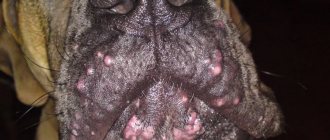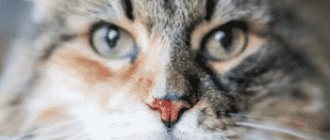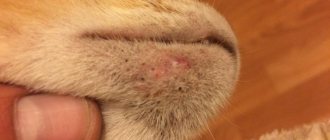Cats are pets in many families. Good owners always try to take care of the health of their pets. Today, this issue should be given special attention, because negative factors such as polluted environment, poor-quality nutrition, vitamin deficiency, contact with stray animals lead to the manifestation of various skin diseases in cats.
Pet owners are concerned about skin diseases in cats associated with the formation of “bald” areas on the body. They are caused by the manifestation of fungal infections (dermatomycosis) on the head, ears and paws. There may also be signs of miliary dermatitis, which is characterized by the presence of crusts, bumps and scales on the skin. Fungal infections are accompanied by varying degrees of itching. You should know that modern manufacturers produce medications for all fungi, including ringworm. These are special sprays and shampoos that need to be used to treat the animal three to five times. The skin of animals with a weakened immune system is often affected by Candida and Malassezia (yeast-type) fungi. In this case, veterinarians recommend the use of shampoos containing nystatin, enilconazole, miconazole, and intraconazole.
Common skin diseases in cats are bacterial infections. They come in two types - dry and wet. When a wet type infection enters the body, redness, sputum, blisters, cracks, and ulcers appear on the animal’s skin. The dry type is characterized by signs of miliary dermatitis. Bacterial infections of the outer skin are formed due to a hereditary predisposition, as well as if the animal licks the skin vigorously, suffering from itching.
If your pet often has an upset stomach, vomiting, or decreased activity, then perhaps the problem is an allergic reaction to a certain set of foods. Most often, cats aged four to five years suffer from allergic food dermatitis. Allergies can occur to certain types of fish and meat, dairy products and eggs. Pets scratch their faces, ears and neck intensely with their paws, and they develop miliary dermatitis. It is urgent to eliminate allergens from the animal’s diet; you should purchase special food or products such as soy, venison, turkey, and duck. Those who keep cats at home should know that perfumes and household chemicals can cause an allergic reaction in them: deodorants, antistatic agents, hairsprays, washing powders. In this case, redness, ulcers, and blisters are observed on the exposed areas of the skin. The animal must be removed from the allergenic environment and the condition of the skin will return to normal.
Baldness (alopecia) is a common skin disease in cats. This disease can be either congenital or acquired. From the first days of life, wool deficiency is observed in Devon Rex, as well as Siamese and Mexican breeds. Hereditary hypotrichosis occurs in kittens whose bodies are covered with down. In the second week of life, the fluff rolls off and the animal becomes bald. Then the fur appears again, and falls out again when the cat is six months old. This disease cannot be cured. This cat breed should be excluded from breeding. Often, when moving to a new place of residence, when a new animal appears in the house, cats experience severe stress. Siamese, Burmese, and Abyssinian cats may develop psychogenic alopecia. When experiencing anxiety, animals vigorously lick their skin and in the process injure it. Before carrying out treatment, it is necessary to eliminate the cause of stress and create comfortable conditions for the pet. Short-haired cat breeds are often diagnosed with alopecia (baldness) of the auricle. The fur falls out, and after a certain period of time grows back. In this case, no treatment is required.
Endocrine alopecia is a serious skin disease in cats. It manifests itself due to a malfunction in the body's hormonal system. Partial baldness occurs on the inner abdomen, on the hind legs, in the genital area, on the sides, and in the armpits. This is more of a diffuse reduction in the total amount of fur than complete baldness. With this type of disease, the animal does not experience itching in the affected areas. A sick cat should be shown to a veterinarian, who, based on the results of the examination, will prescribe treatment.
If the owner notices a black nose on a cat, he should think about the health of his pet. The fact is that an animal that does not have diseases should have a clean and slightly moist nose. Only after sleep does this organ have a higher temperature and is dry. Therefore, any signs of sores, scabs, discharge or even anything that looks like dirt should be a cause for concern.
Why is the nose black
Among all the possible reasons for such a deviation, several main ones can be identified. This:
- injuries;
- infections;
- skin diseases.
Only a professional can determine the exact prerequisites for the appearance of such a symptom. However, for those who prefer home treatment, there are some special signs.
Injuries
The first reason for the formation of a crust on a cat’s nose can be a common injury. The fact is that the coat in this area of the cat is quite thin and delicate. Therefore, getting seriously injured is not that difficult. You should examine your pet, because ordinary dried blood can give a black color. It can be removed with a regular damp cloth or cotton wool. If under the crust the nose is of a normal color, you don’t have to worry about the consequences for the animal.
If the kitten is simply scratched, you should not try to get rid of the rough skin.
It will fall away on its own. Of course, the exception is cases when such a crust blocks the airways. Here you need to help your cat. Of course, only a specialist can provide proper care in this case.
Infections
If a cat has a black spot on its nose, which is accompanied by discharge, we can draw conclusions about the presence of more serious diseases. Here you can suspect rhinoinfection, tracheitis or even calicivirus. In this case, other symptoms will appear. The cat may become more lethargic, lose appetite, and show inactivity.
Among other things, you may notice that the pet began to sneeze frequently and rub its face with its paws. Sometimes the disease appears as white or green purulent discharge from the eyes. If such signs appear, you should immediately contact a veterinary clinic. Only a doctor can diagnose and prescribe the correct treatment.
Skin diseases
If a kitten has black crusts in its nose accompanied by skin lesions near this organ, this indicates the viral nature of the disease. It could be a simple bacterial infection or a fungus. In this case, the clinic must give the cat the necessary tests that will determine what is wrong with the pet.
It is important that such diseases can easily be transmitted to humans. If such symptoms are detected, hygiene procedures should be carried out as carefully as possible and it is advisable to minimize contact with the animal.
Black spots on a cat's nose or other place are always a reason for diagnosis. If this symptom appears on the chin, for example, it may indicate acne. Of course, it is not necessary to rush to the clinic on the same day, but such a serious problem cannot be ignored.
Regardless of whether symptoms other than blackheads or spots appear, it is important to provide your cat with proper care. This will keep your pet healthy. With such care the cat will live for many more years.
The cause of the appearance of crusts may be injury - the thin sensitive skin of a cat's nose is easily injured. The cat could have scratched its nose during play, in a fight with fellow tribesmen, or in an unfortunate fall from a height. Examine the animal - if no damage is visible, the cat may have had a nosebleed and the crust is formed by dried blood. Gently wipe your pet's face with damp cotton wool - if the crusts come off easily and the skin underneath is not changed, the cat behaves calmly, breathing is not difficult, most likely, the danger has already passed, but it is better to show the animal to a veterinarian to exclude injuries to internal organs.
If a cat's nose is scratched, there is no need to separate the crust - once it dries, it will come off on its own. Do not let the cat tear off the crust while washing, and if it interferes with his breathing, soften it with warm water, chlorhexidine or Vaseline oil, remove and lubricate the exposed skin with a wound-healing preparation, preferably with antibacterial components in the composition.
Causes of black, dark spots on a cat's nose
Black dots on a furry pet’s nose appear for a variety of reasons (physiological, pathological), among which are:
- breed, genetic predisposition;
- exposure to sunlight;
- metabolic failures;
- hormonal imbalance;
- errors in feeding, improper care;
- endocrine pathologies, chronic diseases;
- sudden change in diet;
- stress, emotional turmoil;
- violation of hygiene rules, feeding from dirty bowls;
- tendency to allergies;
- a sharp change in diet, switching to new foods;
- dermatological problems (contact, chronic, atypical, infectious dermatitis caused by viruses, fungi);
- mycoses;
- problems in the functioning of the liver and pancreas.
READ What you can and cannot feed your pug
As a rule, the mechanism for the appearance of black dots on the nose of cats is associated with an excess, enhanced production of the melanin pigment (responsible for the dark color). Spots on the lobe most often appear with age and are very rare in young kittens.
As for breed predisposition, black spots on the nose can be found in Sphynxes, Devonrexes, Abbishinos, Siamese, Persian, and Himalayan cats.
Infectious diseases
Nasal discharge that hardens in the form of crusts can be a sign of a variety of diseases, including calicivirus, viral rhinotracheitis, and reovirus infection. Pay attention to the cat’s behavior - has he become lethargic, depressed, or has his appetite deteriorated?
A common cause of crusts on the nose is calicivirus infection (calicivirus). In this case, ulcers also appear in the oral cavity.
If a cat often sneezes, rubs its face with its paws, or snores in its sleep, this may indicate that the animal is sick. Other signs of infection include fever, drooling, coughing, and green or yellow purulent discharge from the eyes.
Treatment for infectious diseases in cats is prescribed by a doctor. The sooner symptoms of a disease are detected in a cat, the sooner you need to contact a veterinarian - many diseases, especially kittens, old and weakened animals, develop very quickly, leading to death in the absence of adequate treatment.
Infections
Black crusts on the nose of cats, along with purulent discharge, can be symptoms of infectious diseases. To successfully treat an infection, you should first undergo tests (skin scraping and nasal swab) to determine the nature of the disease. In case of infection, the affected areas are treated with chlorhexidine (Miramistin) and lubricated with levomekol or other antibacterial agents as recommended by a doctor.
The color of a cat's nose always matches the color of its coat.
Important! If left untreated, infectious diseases can lead to complications or even death of the animal.
We should not forget that the health of mustachioed babies, like any children, is more fragile than that of adult animals, so a kitten’s dirty, crusty nose requires immediate action and timely treatment.
You should pay special attention to the health of kittens
Skin and other diseases
The appearance of crusts on the nose often accompanies fungal and bacterial skin lesions. If you suspect a fungus or bacterial infection, you should show the cat to a doctor so that the veterinarian can examine it - make a scraping, conduct a diagnosis using an ultraviolet lamp. Other signs of skin diseases are cracks on the paw pads, ulcerations and scratches on the skin, and areas of split ends and hair falling out.
We should not forget that many skin infections of cats are also dangerous for humans, so try to exclude contacts of younger family members with a sick cat and follow the rules of hygiene.
Sometimes the appearance of crusts on the nose of cats can be caused by allergies: it can be dried discharge from allergic rhinitis or skin irritation.
Cats, and all animals, have the same health problems as humans. There may be pneumonia, “cat flu” and even allergies. Sometimes owners may notice that their beloved domestic cat is sneezing. How can you tell if your cat is sick?
Why a cat sneezes can only be understood by carefully observing its appearance, well-being and behavior. The reason may simply be dust under the cabinet that accidentally got into the pet’s respiratory tract. But if sneezing is repeated, this may be one of the symptoms of an incipient disease.
After this procedure, the cat should be given special anti-flea drops between the shoulder blades. Flea secretions can cause allergies, including sneezing. If, after introducing a new food or immediately after purchasing a chair, your pet begins to sneeze frequently, but no other symptoms are observed, this may be a consequence of an allergy. It is advisable to analyze what has happened new in the cat’s life in the last week, and when exactly he began to show alarming signs. Sometimes it is enough to simply exclude the allergen.
If these measures have not helped at all, and the cat continues to sneeze, there is no need to try to find answers on veterinary forums. After all, from such advice “blindly” you can lose precious time necessary for effective treatment of the animal. The rule of harm of self-medication also applies here. The danger can threaten not only the pet itself, but also other pets, and even the owners themselves. For example, feline toxoplasmosis, as well as chlamydia, are a serious threat of miscarriage in pregnant women.
Sometimes sneezing in cats is accompanied by lacrimation and runny discharge from the nose. At the same time, the animal’s appetite worsens and lethargy appears. Such signs may be present both with the feline herpes virus and with many diseases of the upper respiratory tract caused by fungi, bacteria and viruses: toxoplasmosis, chlamydia, bordetellosis, rhinotracheitis, calicivirus, etc.
In any case, the disease is easier to prevent than to treat. For this purpose, special vaccines are used. It is best to start vaccinating young kittens at six weeks of age. Until the age of fifteen weeks, babies are given several vaccinations at intervals of 3–7 weeks: against leukemia, rabies, cat flu and panleukopenia. Also, do not forget about good animal nutrition and hygiene.
Sources:
- why does a cat sneeze
People sometimes notice the appearance of strange crusts in the nose that can block the nasal passages and interfere with normal breathing. They often have an unpleasant odor, bringing significant discomfort to a person’s life. The reasons for the appearance of crusts in the nose have not been sufficiently studied today, but doctors still have their own assumptions.
The cat's nose is a fantastically complex and precise tool for studying the world around us. Clever kittens, still deaf and completely blind, rely only on their sense of smell, finding milk nipples, the warm side of their mother, littermates and their den by smell. By the nose, the owner determines whether the pet is sick: a dry cat’s nose means it’s hot, a hot nose means the temperature is elevated, a swollen and clogged nose means an infection is suspected.
How does a cat's nose work?
The structure of a cat's nose in a simplified version is two nasal passages (the two nostrils are separated by cartilage, like in humans), leading into a labyrinth of so-called lattice “shells”. A cat, if necessary, can retain a certain aroma in the “nooks and crannies” of the winding labyrinth, getting rid of impurities in order to more accurately identify the smell that interests it. A dirty nose in a cat means a decreased sense of smell, so it is important to ensure that the nasal passages are not clogged with secretions or debris.
After passing through the labyrinth, the molecules irritate odor-sensitive cells that are connected to the olfactory center of the brain, where aroma recognition occurs. There are many more receptors in a cat’s nose than in a human’s nose – a cat’s sense of smell is 15 times better than ours! The cat hides its nose, rubs it and begins to sneeze uncontrollably, sensing the smell of an irritating substance - chemicals, perfumes, spices, citrus fruits, vinegar. The aroma may seem barely noticeable to us, but the cat physically suffers from such amber, so you should not use perfume near the cat or wash your pet's feeder with cleaning products.
In addition to its olfactory function, the nose performs many other tasks. Cats breathe through their nose, the mucous membranes of the nasal passages warm the inhaled air, and inside the nose the air is pre-cleaned from the smallest particles, viruses, and bacteria. When a cat has a hot nose, the thermoregulation function suffers - it is important to pay attention to the temperature of the nose. The skin of the nose is highly sensitive to temperature changes, so cats can determine the temperature of food or surfaces without even touching the object of interest.
The shape of the nose is determined by the structure of the cranial bones and cartilage. The healthiest noses are those of breeds with “natural” proportions. Cats with flattened faces are susceptible to various respiratory diseases because their nasal cartilage and bones are twisted and compressed.
The color of the nose mirror depends on the color and often repeats the color of the fur on the muzzle, but several shades darker. Pigment spots on the nose in tricolor cats and older pets are a common occurrence. But if the nose of an adult cat suddenly changes color, it is advisable to contact a veterinarian. But don’t panic if your cat’s nose turns black with age—over time, the fur, paw pads, eyes, and nose change color. The tendency to change their “image” is especially noticeable among color-point cats (mask, socks, dark ears, dark tail on a light background). Sometimes the fact that a “point” cat’s nose has turned black is explained by cold weather: the cooler the room, the darker the color, including the nose. For light-colored pets, the opposite is true: in winter the nose is pale, and in summer, under the influence of sunlight, the color becomes richer and brighter.
What is a healthy nose like?
It is generally accepted that a cat's nose should be cold and slightly damp. Indeed, a healthy cat’s nose is cool, smooth and may even be slightly slippery to the touch. But after sleep, active play or stress, a cat’s hot nose is normal. If the nose remains dry and warm to the touch for a couple of hours, you should measure your pet’s body temperature, and if there are any other symptoms of illness, immediately contact a veterinarian. A pale and very cold nose in a cat can signal systemic diseases, hypothermia, shock, a sharp drop in body temperature, or poisoning.
If a cat has a white nose, the change in its shade can indicate the functioning of the circulatory system, since the shade of blood is clearly visible through the skin, which is devoid of pigment. For example, a bluish color may be a sign of heart disease or lack of oxygen. Reddish, inflamed nasal mucous membranes can be a sign of rhinitis, infection, or mechanical irritation. When a cat has a red nose, high blood pressure, fever, and allergies are suspected. A yellowish tint to the nose is a sign of liver and kidney disease. In cats whose noses are dark in color, such changes are more difficult to notice. In order not to miss the onset of the disease, instead of the nose, the mucous membranes of the lips and eyelids are examined.
Observation and care
If the cat is in good health, the nose does not need additional care - the pet does everything itself. During hot weather, when the cat has a dry nose, it licks itself, moistening the mucous membranes. Despite natural curiosity and the habit of sniffing everything, a cat’s dirty nose is a reason to wash thoroughly using paw pads and claws. However, the owner should regularly inspect the nose and touch it with the back of his hand: if the cat’s usually cold nose suddenly becomes hot and dry, it is worth taking a closer look at the pet.
How to clean a cat’s nose if such a need arises? This is a simple manipulation, but you need to act delicately so as not to cause aggression or scare your pet. The fidget is smeared in flour or the cat's nose is stuffy - you can't get inside the nasal passages. Clean only the visible part using moistened cotton swabs with a limiter. You need to move from the inner edge to the outer, removing accumulated debris, discharge or dried crusts. If your cat is not breathing through its nose, you should contact your veterinarian. The cause of obstruction of the nasal passages can be foreign objects, tumors, dried blood and much more: you should not try to clear your nose yourself, this can lead to injury.
To prevent a cat’s wet nose after cleaning from causing rhinitis or bronchitis (if the room is cool), the moisture should be removed with a paper napkin. There is no need to rub your nose - a light touch is enough. Napkins should be uncolored (especially if the cat has a white nose and/or light fur on the face) and odorless: chemical dyes and fragrances often cause allergies, local irritations and dermatitis. In addition, the cat's sensitive sense of smell may be affected after such care. For the same reason, you need to clean the spout with ordinary boiled water, without using special liquids unless absolutely necessary.
Do not forget that a healthy cat’s nose should always be clean, slightly shiny and even, without scabs, crusts, or flaky areas. If you notice any changes, especially if they appear regularly or do not disappear within 24 hours, be sure to visit a veterinarian. On the other hand, a cat’s cool, wet nose does not mean that the pet is completely healthy - simply touching the nose is not enough to assess the condition.
Source: vashipitomcy.ru
Similar articles:
Random facts from the life of cats and dogs
Isaac Newton, who is known as the discoverer of the law of attraction, invented a door for domestic cats. - facts about cats
Causes of crusts
According to modern ENT specialists, the development of dry and unpleasant-smelling crusts in the nose is provoked by congenital pathologies of the nasal cavity, for example, an overly wide nose or underdeveloped paranasal sinuses, which are present in people with a wide face. There is also a version that the appearance of these crusts causes a pathological degeneration of the nasal mucosa, during which it disintegrates and dries on the inner walls of the nostrils in the form of crust-like formations.
The conversion of one tissue type to another in nasal crusting changes the columnar ciliated epithelium to a squamous epithelial layer.
When bloody, painful crusts form in the nose, atrophic chronic inflammation of the mucous membrane of the nasal passages should be suspected. In this case, it is important to consult a qualified doctor to determine the exact cause of the appearance of crusts and take a special course to treat the disorder. Before this, you can soften the crusts using non-aggressive nasal drops, which will help eliminate dryness and tightness in the nose, causing constant discomfort and pain in the nostril area.
Non-communicable causes
There are the following types of non-infectious diseases in which crusts form on the nose:
- allergic conditions;
- injuries;
- violation of conditions of detention.
Allergic conditions
All allergens that cause a runny nose lead to the release of exudate, which dries out and crusts form. The nasal mirror is injured by hard scabs, ichor is released, secondary microflora is added and the pet’s condition worsens.
The development of a hypersensitive reaction is influenced by the following unfavorable factors:
- increased sensitivity to feed mixture ingredients;
- response to pollen from flowering plants;
- irritating effects of perfume odors, tobacco smoke, household chemicals;
- irritating effects of toys, tray filler, bedding made of synthetic materials;
- reaction to human hair or the fur of other pets;
- side effects of medications.
Treatment consists of eliminating the causes. Caused an inappropriate reaction. They stop taking medications that can cause an allergic response and switch to ready-made hypoallergenic food.
Remove objects that emit odors from the room and stop smoking in the presence of the pet. Change the tray filler and bedding. In some situations, the use of antihistamines is required.
Injuries
Such crusts heal on their own. Crusts are formed if a cat scratches its nose in a fight or through contact with sharp or prickly objects. When you hit the nose, slight bleeding may occur; the released liquid dries, forming crusts. If there is no suppuration under the scabs, observe the healing process of skin defects. Otherwise, use an antiseptic wound-healing ointment.
Be sure to read:
The cat eats poorly and loses weight: causes, safe and dangerous symptoms, first aid, treatment
Violation of containment conditions.
When the central heating is turned on in winter or during hot weather, the air dries out and the skin on the cat's nose cracks. The ichor is released, which dries and forms crusts. If in hot weather the cat is exposed to a stream of cold air from an air conditioner, hypothermia develops and rhinitis occurs, in which snot is released from the nose. They dry out and form crusts.
Frequent bathing in combination with drafts in the apartment also leads to hypothermia and rhinitis. Treatment consists of introducing immunomodulatory or antimicrobial drops into the nasal cavity.
Treatment of crusts
Most often, doctors resort to conservative treatment of nasal crusts, the purpose of which is to moisturize the nasal mucosa with the help of special mineral solutions. Thanks to finely dispersed irrigation, the patient gets rid of unpleasant-smelling formations in the nose. In addition, this type of treatment prevents the formation of new crusts. Today, well-proven photodynamic therapy is widely used to restore the nasal mucosa.
The use of iontophoresis, photodynamics and physiotherapeutic procedures can significantly improve the patient’s condition and even successfully cure him.
Also, to treat crusts in the nose, doctors resort to organotherapy, which significantly improves and stabilizes local immunity, activating lymph flow in the upper respiratory tract. Surgery is the most radical method of treating this pathology, which involves pressing the inner wall of the maxillary sinus towards the nasal septum. The separated wall is fixed in the desired position using a tampon and, after fusion of the nasal septum with the surface of the nasal concha, it remains in this state without tamponing.
Having discovered tubercles on a cat’s ears, what to treat is a logical question. Before starting therapy, the cause of the appearance of bumps on the animal’s skin should be determined. Many dermatological diseases are accompanied by similar formations in the layers of the epidermis. A correct diagnosis can only be made in a specialized veterinary institution.
Subcutaneous mite: types of pathogen
Sarcoptes scabiei lays eggs in the thickness of a cat's skin
- Demodex folliculorum (causative agent of demodicosis);
- Sarcoptes scabiei (cause of sarcoptic mange);
- Notoedrosis (causes notoedrosis);
- Cheyletiella (the causative agent of cheyletiellosis);
- Trombiculidae (cause thrombiculosis).
Demodex folliculorum (causative agent of demodicosis)
Sarcoptic mange is not much different from demodectic mange. The pathogen Sarcoptes scabiei lives in the skin of an animal for years without causing concern. The clinical picture of sarcoptic mange is more pronounced: deep damage to the epidermis, ulcers, and fistulas are observed.
Notoedrosis (causes notoedrosis)
Cheyletilleosis (stray dandruff) most often affects young individuals with a weak immune system. The pathogen, moving through the thickness of the skin, makes it lumpy.
Less common in cats is a skin disease such as thrombiculosis, which is also dangerous for humans. The pathology is characterized by seasonal manifestations - from spring to autumn.
Symptoms of infection
Clinical signs of a subcutaneous tick in a pet are as follows:
- itching, restlessness, constant scratching and licking of the fur;
- untidy appearance of the coat: disheveled, disheveled, the coat hangs in “icicles” and loses its natural shine;
- tubercles and skin irregularities are felt on the ears, muzzle and other parts of the body;
- Dried crusts, peeling, and dandruff are observed at the site of scratching;
- growths and fluid discharge (ichor) are observed on the skin;
- bald spots, bald spots, lesions;
- the animal becomes lethargic and its appetite decreases.
The defeat of a pet by subcutaneous mites occurs in two forms: localized (local) and generalized (general). In the first case, foci of infection are observed on the head, muzzle and ears. If the lesion is global in nature, then the paws, back and sides of the animal are included in the pathological process.
The consequences of a particular disease rarely threaten the life of the animal, but often lead to a deterioration in the pet’s appearance: hair falls out, bald patches appear, and baldness appears. Therefore, the question of what to do if a cat has subcutaneous mites is relevant for the owner.
How to make a diagnosis
The effectiveness of treatment for subcutaneous mites largely depends on the correctness of the diagnosis and identification of the type of pathogen. To do this, an animal with signs of skin pathology should be shown to a veterinarian. After a clinical examination, biological samples will be taken at a specialized institution for microscopic analysis.
Scrapings (4 - 5 times) are taken from the hair follicle, since it is in it that the pathogenic microorganism is localized. During the procedure, blood often appears at the site where the material is taken - this is normal, and the owner should not worry. Without taking material from the deep layers of the skin, it is impossible to make a correct diagnosis.
Subcutaneous mites are differentiated from ringworm, dermatoses, and allergies based on clinical signs and laboratory diagnostic methods.
Treatment of the disease
Having heard a diagnosis from a veterinarian, the owner usually wants to know how to treat subcutaneous mites in cats. Treatment of the disease is complex. Not only specific acaricidal drugs will be required, but also immunomodulators and antibiotics. In advanced cases, patience and perseverance are required from the owner, as the healing process can take months.
When treating an animal, it is necessary to disinfect care items (combs, slickers, etc.), premises, and bedding. This will prevent re-infection.
The effectiveness of the therapy should be monitored using laboratory methods, with regular scrapings done in a veterinary clinic. A complete cure is considered when two negative results are achieved. If there are other animals living in the house, they should be shown to a veterinarian.
Other reasons
Milliary dermatitis
The reason that a cat has bumps on the ears, roughness and bumpiness of the skin is not always a subcutaneous mite. Similar signs may be observed in a pet in the following cases:
Clinical symptoms of skin diseases are very diverse. For differential diagnosis, laboratory, microscopic and allergic research methods are used. Therefore, if you find bumps, roughness and other skin pathologies in your pet, you must visit a veterinary clinic.
What to do if your cat has black spots on his nose
If the dark spots periodically disappear and appear, but the cat feels fine, do not worry. Perhaps the appearance of black dots on the nose is caused by the pet’s exposure to the sun or other harmless factors (genetic predisposition, change of diet).
READ Should you worry if your cat's whiskers fall out?
At home, you can wipe your cat’s nose with hydrogen peroxide 2-3 times a day. The solution is diluted 1/1 in water. You can use antiseptics (miramistin, chlorhexidine), decoctions of medicinal herbs (calendula, chamomile).
In all other cases, if there are obvious signs of illness, take the cat to the clinic for examination.











